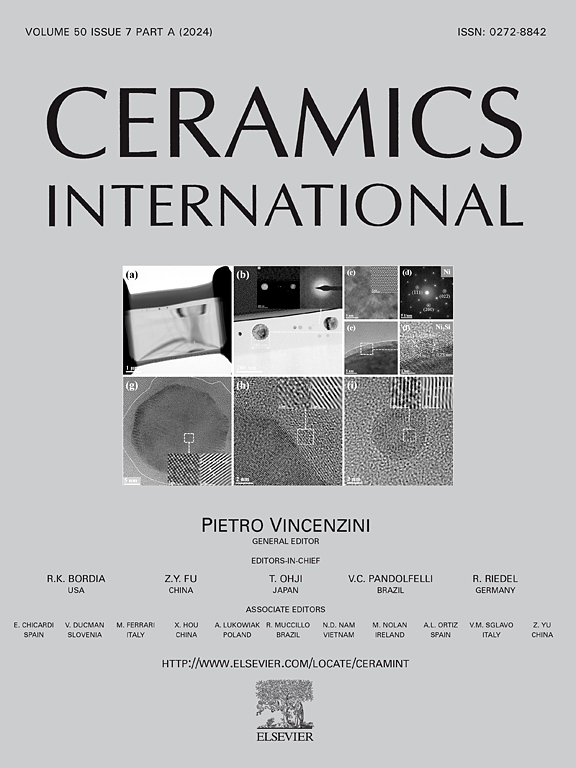关于碳化硅粒子增强 Al-MMC 超声波辅助磨削过程中韧性-脆性转变临界条件的研究
IF 5.1
2区 材料科学
Q1 MATERIALS SCIENCE, CERAMICS
引用次数: 0
摘要
高体积分数(45%)碳化硅颗粒增强铝基复合材料(SiCp/Al-MMCs)因其卓越的性能在各种工程领域发挥着重要作用。然而,加工过程中碳化硅颗粒断裂造成的损伤会导致表面完整性差,严重影响 SiCp/Al 复合材料结构部件的疲劳性能。超声波辅助磨削(UAG)被认为有利于促进硬脆材料的韧性磨削。本研究重点关注 SiCp/Al 复合材料超声辅助磨削过程中延性-脆性转变的临界条件,并建立了延性磨削临界未变形切屑厚度 (UCT) 的机理和数据驱动模型,以准确预测材料去除模式。该模型综合考虑了切屑形态、去除模式转换机制和磨削表面损伤特征。利用响应面方法学(RSM)和遗传算法(GA)修正了加工参数对去除机制的影响。通过超声波辅助侧磨和端磨实验,深入探讨了不同的未变形切屑厚度、磨削速度和超声波振幅对表面损伤的影响,以及韧性-脆性转变的临界条件。研究结果证实了实验数据与预测值的一致性。超声波振动可有效减少 SiCp/Al 复合材料中 SiC 颗粒的脆性断裂。适当提高磨削速度和减小切屑厚度可以提高韧性磨削的临界切屑厚度,降低脆性表面的比例,从而实现表面完整性和磨削效率之间的平衡。这项研究为 SiCp/Al 复合材料的高性能加工提供了指导。本文章由计算机程序翻译,如有差异,请以英文原文为准。
Study on the critical conditions for ductile-brittle transition in ultrasonic-assisted grinding of SiC particle-reinforced Al-MMCs
High volume fraction (45 %) silicon carbide particle-reinforced aluminum matrix composites (SiCp/Al-MMCs) play a significant role in various engineering fields due to their outstanding performance. However, damages characterized by SiC particle fracture during machining lead to poor surface integrity, which severely affects the fatigue performance of SiCp/Al composite structural components. Ultrasonic-assisted grinding (UAG) is acknowledged as beneficial for promoting ductile grinding in hard and brittle materials. This study focuses on the critical conditions for ductile-brittle transition in ultrasonic-assisted grinding of SiCp/Al composites and develops a mechanism and data driven model of critical undeformed chip thickness (UCT) for ductile grinding to accurately predict the material removal mode. The model thoroughly integrates considerations of chip morphology, removal mode transition mechanism, and grinding surface damage characteristics. Response surface methodology (RSM) and genetic algorithms (GA) were utilized to correct the impact of processing parameters on the removal regime. Experiments on ultrasonic-assisted side and end grinding were conducted to thoroughly discuss the effects of different undeformed chip thicknesses, grinding speeds and ultrasonic vibration amplitude on surface damage and the critical conditions for the ductile-brittle transition. The findings corroborate the experimental data with the predicted values. Ultrasonic vibration can effectively reduce the brittle fracture of SiC particles in SiCp/Al composites. Appropriately increasing the grinding speed and reducing the chip thickness can enhance the critical chip thickness for ductile grinding and decrease the proportion of brittle surfaces, thereby achieving a balance between surface integrity and grinding efficiency. This research provides guidance for high-performance machining of SiCp/Al composites.
求助全文
通过发布文献求助,成功后即可免费获取论文全文。
去求助
来源期刊

Ceramics International
工程技术-材料科学:硅酸盐
CiteScore
9.40
自引率
15.40%
发文量
4558
审稿时长
25 days
期刊介绍:
Ceramics International covers the science of advanced ceramic materials. The journal encourages contributions that demonstrate how an understanding of the basic chemical and physical phenomena may direct materials design and stimulate ideas for new or improved processing techniques, in order to obtain materials with desired structural features and properties.
Ceramics International covers oxide and non-oxide ceramics, functional glasses, glass ceramics, amorphous inorganic non-metallic materials (and their combinations with metal and organic materials), in the form of particulates, dense or porous bodies, thin/thick films and laminated, graded and composite structures. Process related topics such as ceramic-ceramic joints or joining ceramics with dissimilar materials, as well as surface finishing and conditioning are also covered. Besides traditional processing techniques, manufacturing routes of interest include innovative procedures benefiting from externally applied stresses, electromagnetic fields and energetic beams, as well as top-down and self-assembly nanotechnology approaches. In addition, the journal welcomes submissions on bio-inspired and bio-enabled materials designs, experimentally validated multi scale modelling and simulation for materials design, and the use of the most advanced chemical and physical characterization techniques of structure, properties and behaviour.
Technologically relevant low-dimensional systems are a particular focus of Ceramics International. These include 0, 1 and 2-D nanomaterials (also covering CNTs, graphene and related materials, and diamond-like carbons), their nanocomposites, as well as nano-hybrids and hierarchical multifunctional nanostructures that might integrate molecular, biological and electronic components.
 求助内容:
求助内容: 应助结果提醒方式:
应助结果提醒方式:


